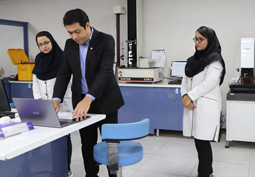-px.jpg)
The production of wires and cables is a multifaceted process that involves the transformation of raw materials into finished products. The equipment utilized in the industry is central to this process and forms the backbone of production. Therefore, the selection of wire and cable production machines is vital, as it directly impacts product quality and work efficiency
Key Equipment in Cable and Wire Production
The production of wires and cables is a multifaceted process that involves the transformation of raw materials into finished products. The equipment utilized in the industry is central to this process and forms the backbone of production. Therefore, the selection of wire and cable production machines is vital, as it directly impacts product quality and work efficiency.
Given that the cables and wires have diverse components; their production involves a protracted procedure. This process requires oversight from specialized experts and the utilization of cutting-edge machinery equipped with the latest technology. Esteemed factories prioritize the importance of selecting high-performance machines for successful wire and cable production stages.
Today, wire and cable production machines have undergone significant positive advancements. Equipment used in the production process includes Rod Thinning machines, Fine Thinning machines, Bunching machines, Coating machines, and Stranding machines. These machines are essential for ensuring the stability and quality of the final product, given the sensitivity of wires and cables. Reputable brands consistently use the most advanced and precise machinery to guarantee the quality of their products.
A notable advantage of using modern wire and cable production machines is the enhancement of productivity by performing tasks more efficiently and more rapidly. Therefore, these machines increase the speed of cable and wire production and in addition, they eliminate human errors and contribute to the improvement of product quality. The precision of the machinery employed by reputable brands results in the higher quality of their products which face a great reception and demand by the consumers.
Introducing Essential Machines for Wire and Cable Production
In the wire and cable production process, the specialized machines that are used by the top brands in the Iranian market for efficient and precise manufacturing are as follows:
Rod Stretching Machine: Typically used to stretch and facilitate the finishing works. Wires are fed into this machine and are then divided into smaller dimensions to achieve the desired thickness.
Fine Thinning Machine: This device is primarily used to stretch wires from the exit section of the rod stretching machine. Its main use is to produce extra thin wires.
Stranding Machine: Wires stretched on the spools are fed into the stranding machine for insulation purposes. This machine is particularly utilized for weaving aluminum, copper, and carbon steel wires at a high speed.
Extrusion Machine: This device is used for injecting special materials and insulating wires and cables, which ensures their durability and performance.
Bunching Machine: The bunching Machine is utilized for arranging cables in a uniform structure, applying covers, and enhancing the overall quality and functionality of the cables.
Summary of Cable and Wire Production Stages and Machinery
The cable and wire production process follows the same procedure in most factories. These processes include stretching, annealing, twisting of copper strands, insulation, coating, and more stages. Reputable brands use modern equipment and machinery to execute these steps, and therefore, they produce high-quality and durable wires and cables with global standards. The advanced technology of these devices minimizes human error which further improves the quality of the final products. Some additional details regarding the specific steps of cable and wire production are mentioned below:
Stretching: This is a critical stage in cable and wire production. It determines the diameter and the final tensile strength of wires.
Coating: The type of insulation material is dependent on the intended application. For instance, cables used in harsh environments like underground cables must be covered with materials that are resistant to moisture and corrosion.
Grouping: The number of strands in a cable is determined by the amount of current it needs to carry. For instance, compared to smaller machinery, larger machines require wires with more strands in order to be powered.
Covering: The type of material used in the protective layer is dependent on the intended application as well. For instance, wires used in open spaces must be applied with additional protective layers based on the specific application, ensuring resistance to sunlight and erosion for outdoor cables.
Testing: Finished products undergo testing to ensure they meet required standards. This testing could include assessments of electrical conductivity, tensile strength, and insulation resistance.

-px.jpg)
-px.jpg)

